Taxation Law Case Study: CGT Implications for Harrison Carter
VerifiedAdded on 2022/09/08
|6
|1189
|14
Case Study
AI Summary
This case study analyzes the capital gains tax (CGT) implications for Harrison Carter, an Australian resident. The assignment addresses the timing of CGT events, referencing relevant sections of the ITAA 1997 and supporting case law. Part 1 explains the timing of a CGT event with relevant legal references. Part 2 calculates Harrison's net capital gains or losses for the tax years ending 2018 and 2019, considering the sale of an investment property and shares acquired in 1985. The analysis includes details on the acquisition and disposal of assets, applying the CGT rules to determine the tax consequences. The case study also considers the treatment of capital losses and their potential impact on future capital gains. References to legal cases such as FCT v Sara Lee Household (2002) and McDonald v FCT (1998) are included to support the analysis.
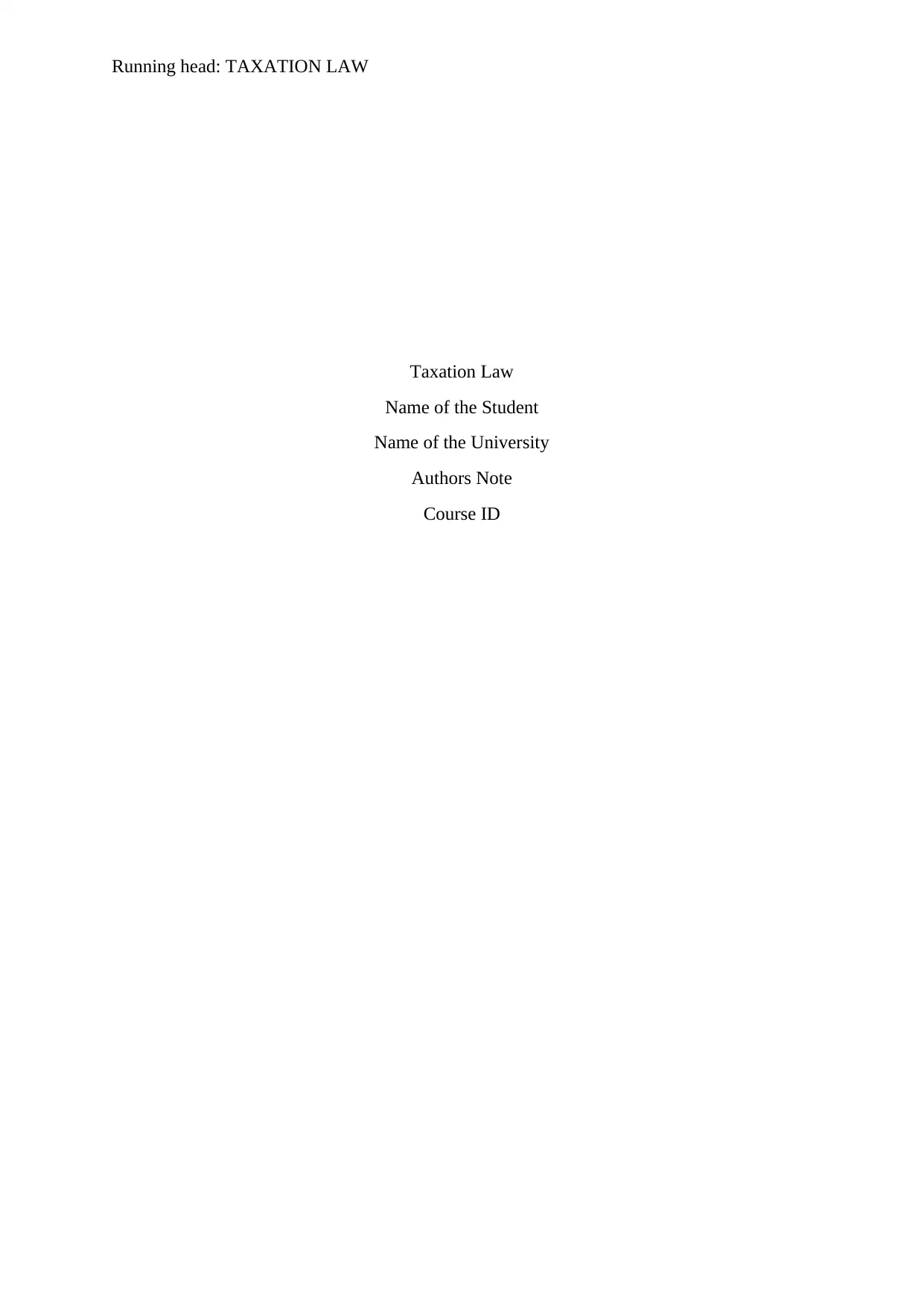
Running head: TAXATION LAW
Taxation Law
Name of the Student
Name of the University
Authors Note
Course ID
Taxation Law
Name of the Student
Name of the University
Authors Note
Course ID
Paraphrase This Document
Need a fresh take? Get an instant paraphrase of this document with our AI Paraphraser
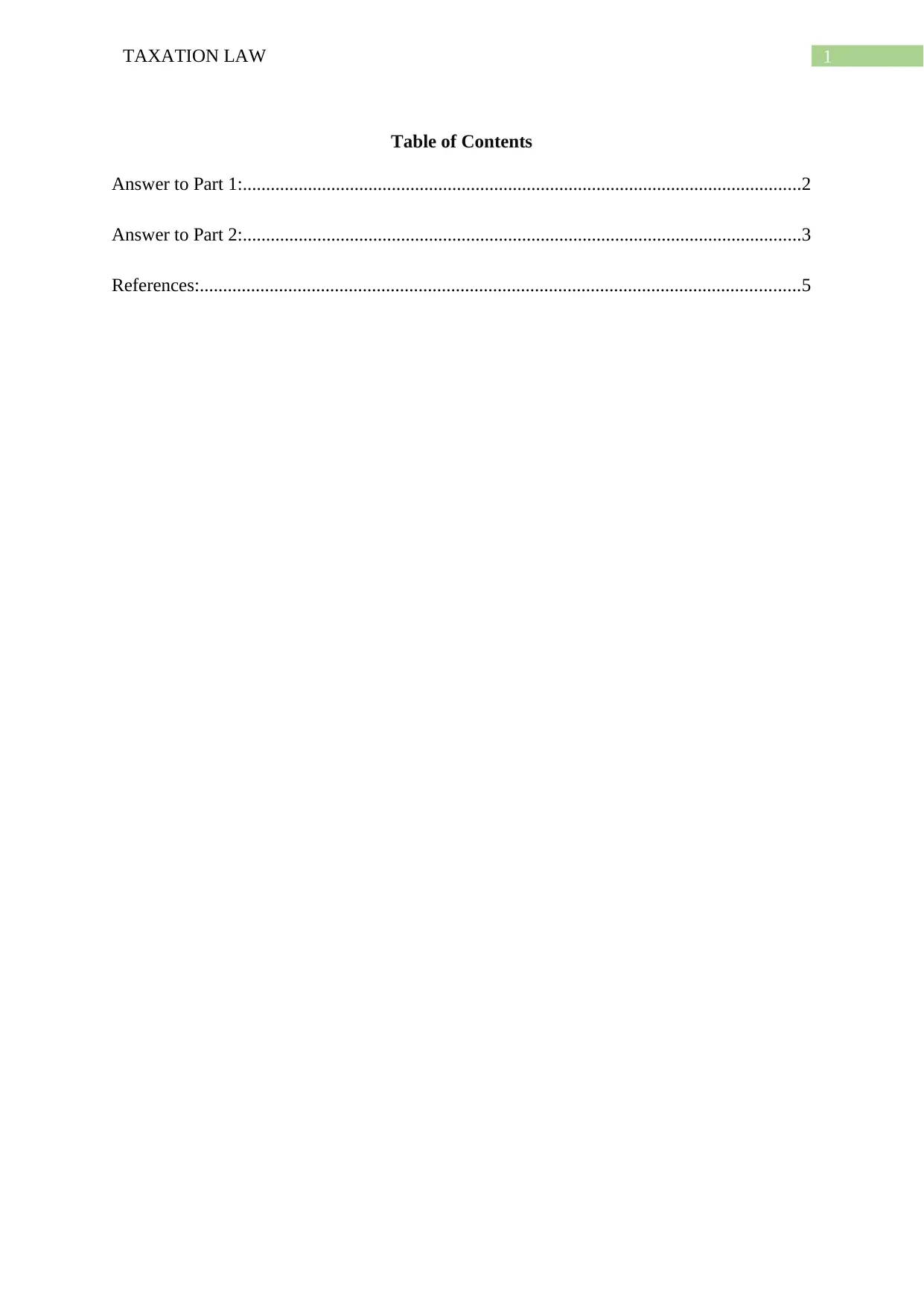
1TAXATION LAW
Table of Contents
Answer to Part 1:........................................................................................................................2
Answer to Part 2:........................................................................................................................3
References:.................................................................................................................................5
Table of Contents
Answer to Part 1:........................................................................................................................2
Answer to Part 2:........................................................................................................................3
References:.................................................................................................................................5
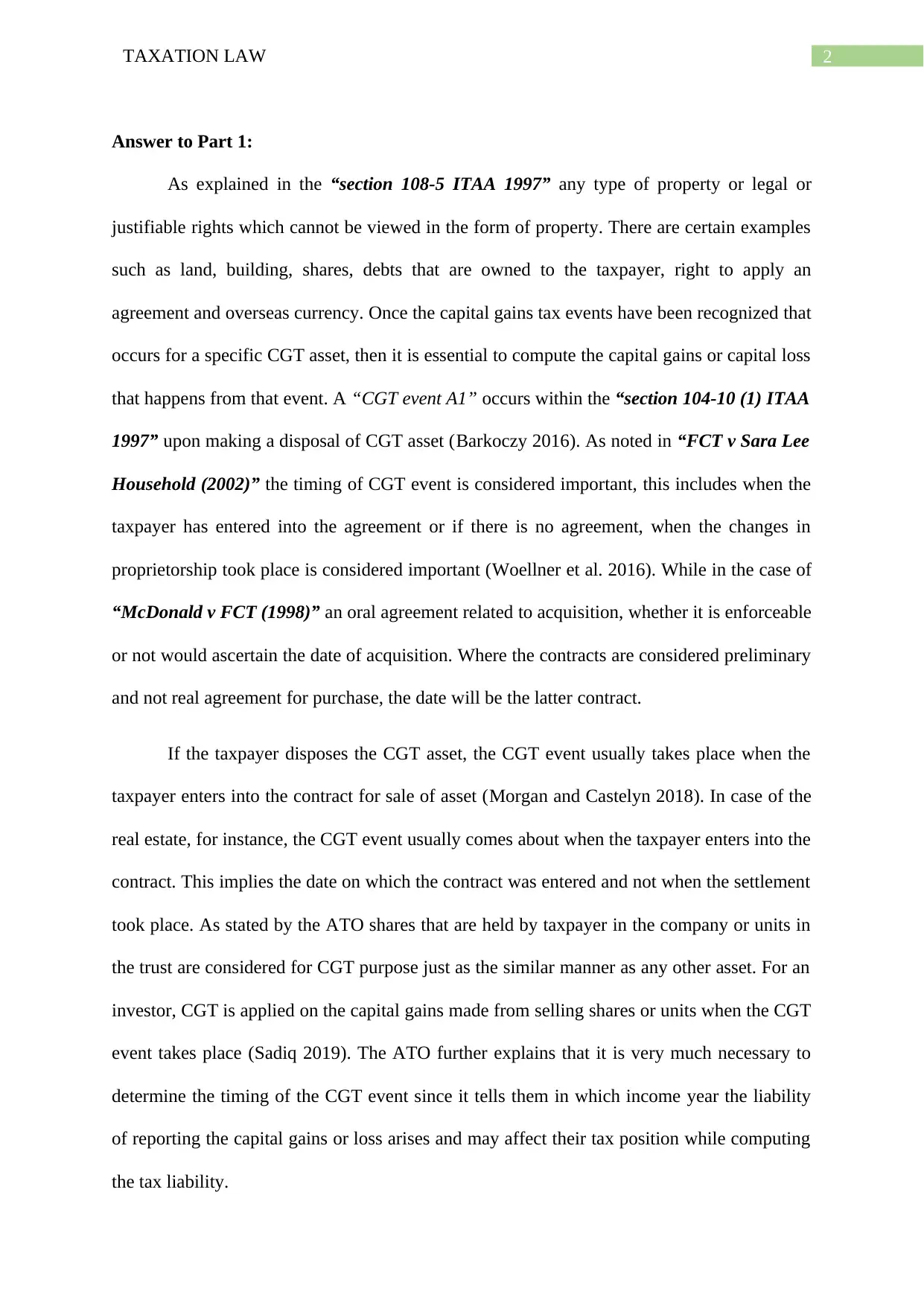
2TAXATION LAW
Answer to Part 1:
As explained in the “section 108-5 ITAA 1997” any type of property or legal or
justifiable rights which cannot be viewed in the form of property. There are certain examples
such as land, building, shares, debts that are owned to the taxpayer, right to apply an
agreement and overseas currency. Once the capital gains tax events have been recognized that
occurs for a specific CGT asset, then it is essential to compute the capital gains or capital loss
that happens from that event. A “CGT event A1” occurs within the “section 104-10 (1) ITAA
1997” upon making a disposal of CGT asset (Barkoczy 2016). As noted in “FCT v Sara Lee
Household (2002)” the timing of CGT event is considered important, this includes when the
taxpayer has entered into the agreement or if there is no agreement, when the changes in
proprietorship took place is considered important (Woellner et al. 2016). While in the case of
“McDonald v FCT (1998)” an oral agreement related to acquisition, whether it is enforceable
or not would ascertain the date of acquisition. Where the contracts are considered preliminary
and not real agreement for purchase, the date will be the latter contract.
If the taxpayer disposes the CGT asset, the CGT event usually takes place when the
taxpayer enters into the contract for sale of asset (Morgan and Castelyn 2018). In case of the
real estate, for instance, the CGT event usually comes about when the taxpayer enters into the
contract. This implies the date on which the contract was entered and not when the settlement
took place. As stated by the ATO shares that are held by taxpayer in the company or units in
the trust are considered for CGT purpose just as the similar manner as any other asset. For an
investor, CGT is applied on the capital gains made from selling shares or units when the CGT
event takes place (Sadiq 2019). The ATO further explains that it is very much necessary to
determine the timing of the CGT event since it tells them in which income year the liability
of reporting the capital gains or loss arises and may affect their tax position while computing
the tax liability.
Answer to Part 1:
As explained in the “section 108-5 ITAA 1997” any type of property or legal or
justifiable rights which cannot be viewed in the form of property. There are certain examples
such as land, building, shares, debts that are owned to the taxpayer, right to apply an
agreement and overseas currency. Once the capital gains tax events have been recognized that
occurs for a specific CGT asset, then it is essential to compute the capital gains or capital loss
that happens from that event. A “CGT event A1” occurs within the “section 104-10 (1) ITAA
1997” upon making a disposal of CGT asset (Barkoczy 2016). As noted in “FCT v Sara Lee
Household (2002)” the timing of CGT event is considered important, this includes when the
taxpayer has entered into the agreement or if there is no agreement, when the changes in
proprietorship took place is considered important (Woellner et al. 2016). While in the case of
“McDonald v FCT (1998)” an oral agreement related to acquisition, whether it is enforceable
or not would ascertain the date of acquisition. Where the contracts are considered preliminary
and not real agreement for purchase, the date will be the latter contract.
If the taxpayer disposes the CGT asset, the CGT event usually takes place when the
taxpayer enters into the contract for sale of asset (Morgan and Castelyn 2018). In case of the
real estate, for instance, the CGT event usually comes about when the taxpayer enters into the
contract. This implies the date on which the contract was entered and not when the settlement
took place. As stated by the ATO shares that are held by taxpayer in the company or units in
the trust are considered for CGT purpose just as the similar manner as any other asset. For an
investor, CGT is applied on the capital gains made from selling shares or units when the CGT
event takes place (Sadiq 2019). The ATO further explains that it is very much necessary to
determine the timing of the CGT event since it tells them in which income year the liability
of reporting the capital gains or loss arises and may affect their tax position while computing
the tax liability.
⊘ This is a preview!⊘
Do you want full access?
Subscribe today to unlock all pages.

Trusted by 1+ million students worldwide
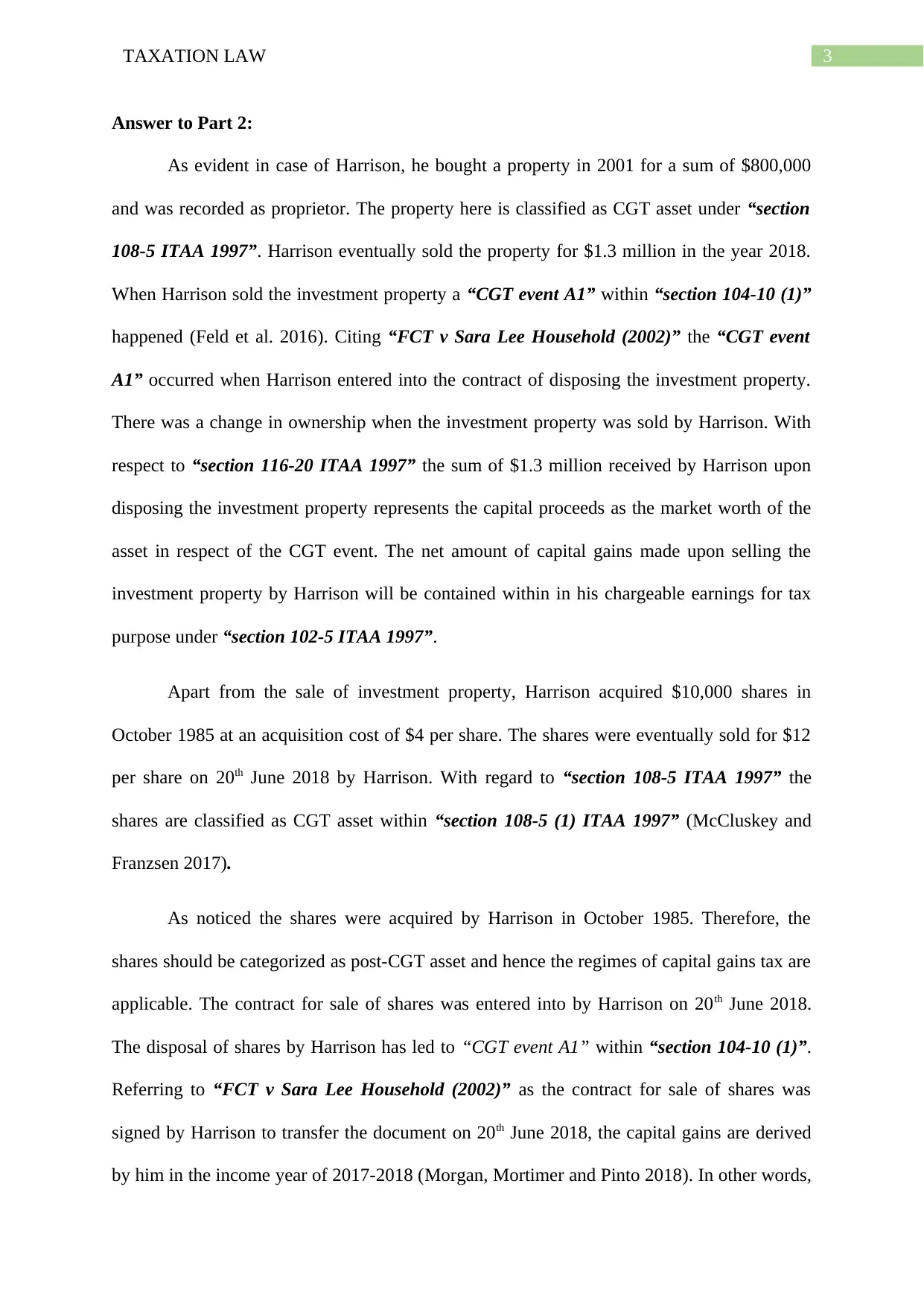
3TAXATION LAW
Answer to Part 2:
As evident in case of Harrison, he bought a property in 2001 for a sum of $800,000
and was recorded as proprietor. The property here is classified as CGT asset under “section
108-5 ITAA 1997”. Harrison eventually sold the property for $1.3 million in the year 2018.
When Harrison sold the investment property a “CGT event A1” within “section 104-10 (1)”
happened (Feld et al. 2016). Citing “FCT v Sara Lee Household (2002)” the “CGT event
A1” occurred when Harrison entered into the contract of disposing the investment property.
There was a change in ownership when the investment property was sold by Harrison. With
respect to “section 116-20 ITAA 1997” the sum of $1.3 million received by Harrison upon
disposing the investment property represents the capital proceeds as the market worth of the
asset in respect of the CGT event. The net amount of capital gains made upon selling the
investment property by Harrison will be contained within in his chargeable earnings for tax
purpose under “section 102-5 ITAA 1997”.
Apart from the sale of investment property, Harrison acquired $10,000 shares in
October 1985 at an acquisition cost of $4 per share. The shares were eventually sold for $12
per share on 20th June 2018 by Harrison. With regard to “section 108-5 ITAA 1997” the
shares are classified as CGT asset within “section 108-5 (1) ITAA 1997” (McCluskey and
Franzsen 2017).
As noticed the shares were acquired by Harrison in October 1985. Therefore, the
shares should be categorized as post-CGT asset and hence the regimes of capital gains tax are
applicable. The contract for sale of shares was entered into by Harrison on 20th June 2018.
The disposal of shares by Harrison has led to “CGT event A1” within “section 104-10 (1)”.
Referring to “FCT v Sara Lee Household (2002)” as the contract for sale of shares was
signed by Harrison to transfer the document on 20th June 2018, the capital gains are derived
by him in the income year of 2017-2018 (Morgan, Mortimer and Pinto 2018). In other words,
Answer to Part 2:
As evident in case of Harrison, he bought a property in 2001 for a sum of $800,000
and was recorded as proprietor. The property here is classified as CGT asset under “section
108-5 ITAA 1997”. Harrison eventually sold the property for $1.3 million in the year 2018.
When Harrison sold the investment property a “CGT event A1” within “section 104-10 (1)”
happened (Feld et al. 2016). Citing “FCT v Sara Lee Household (2002)” the “CGT event
A1” occurred when Harrison entered into the contract of disposing the investment property.
There was a change in ownership when the investment property was sold by Harrison. With
respect to “section 116-20 ITAA 1997” the sum of $1.3 million received by Harrison upon
disposing the investment property represents the capital proceeds as the market worth of the
asset in respect of the CGT event. The net amount of capital gains made upon selling the
investment property by Harrison will be contained within in his chargeable earnings for tax
purpose under “section 102-5 ITAA 1997”.
Apart from the sale of investment property, Harrison acquired $10,000 shares in
October 1985 at an acquisition cost of $4 per share. The shares were eventually sold for $12
per share on 20th June 2018 by Harrison. With regard to “section 108-5 ITAA 1997” the
shares are classified as CGT asset within “section 108-5 (1) ITAA 1997” (McCluskey and
Franzsen 2017).
As noticed the shares were acquired by Harrison in October 1985. Therefore, the
shares should be categorized as post-CGT asset and hence the regimes of capital gains tax are
applicable. The contract for sale of shares was entered into by Harrison on 20th June 2018.
The disposal of shares by Harrison has led to “CGT event A1” within “section 104-10 (1)”.
Referring to “FCT v Sara Lee Household (2002)” as the contract for sale of shares was
signed by Harrison to transfer the document on 20th June 2018, the capital gains are derived
by him in the income year of 2017-2018 (Morgan, Mortimer and Pinto 2018). In other words,
Paraphrase This Document
Need a fresh take? Get an instant paraphrase of this document with our AI Paraphraser
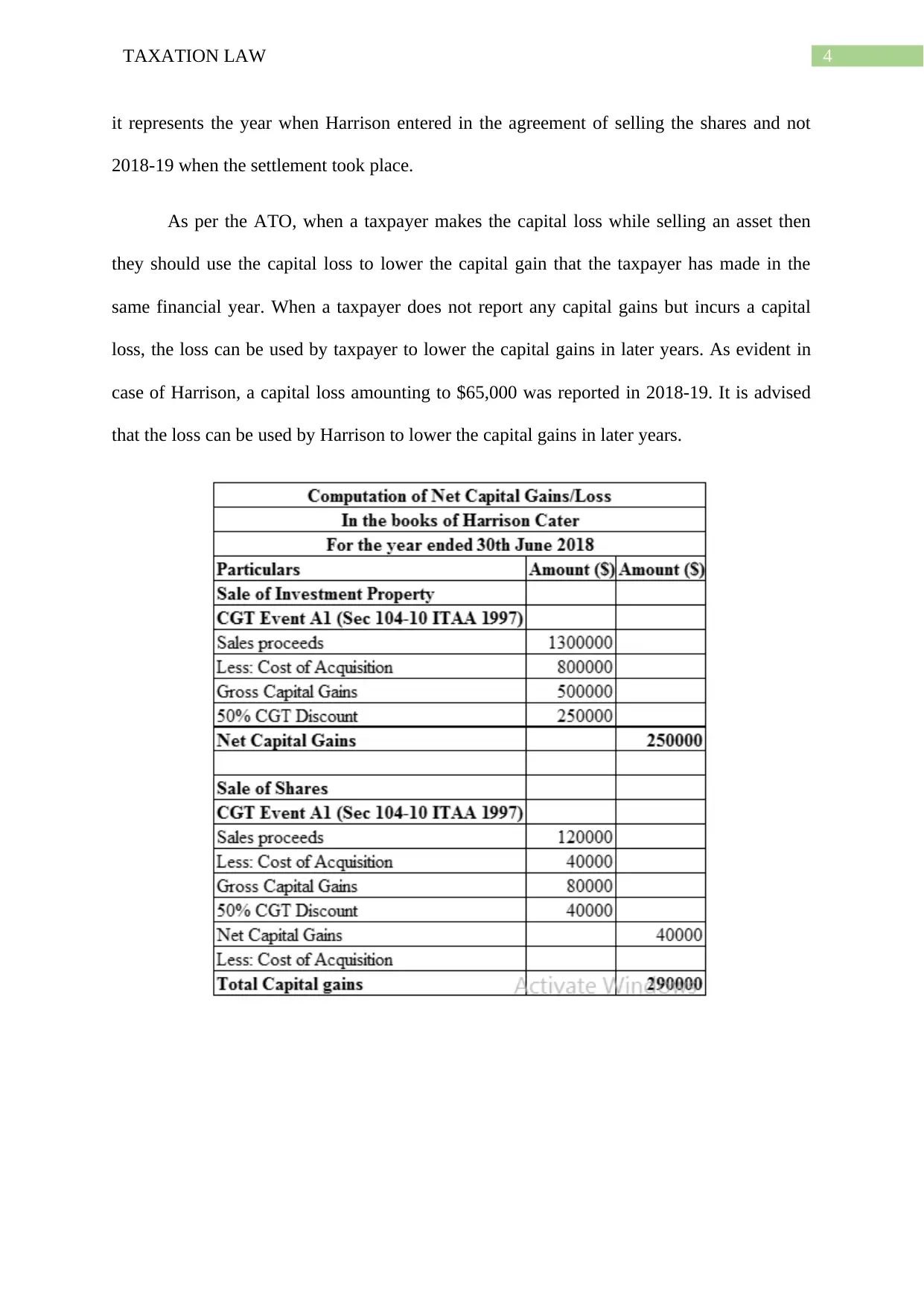
4TAXATION LAW
it represents the year when Harrison entered in the agreement of selling the shares and not
2018-19 when the settlement took place.
As per the ATO, when a taxpayer makes the capital loss while selling an asset then
they should use the capital loss to lower the capital gain that the taxpayer has made in the
same financial year. When a taxpayer does not report any capital gains but incurs a capital
loss, the loss can be used by taxpayer to lower the capital gains in later years. As evident in
case of Harrison, a capital loss amounting to $65,000 was reported in 2018-19. It is advised
that the loss can be used by Harrison to lower the capital gains in later years.
it represents the year when Harrison entered in the agreement of selling the shares and not
2018-19 when the settlement took place.
As per the ATO, when a taxpayer makes the capital loss while selling an asset then
they should use the capital loss to lower the capital gain that the taxpayer has made in the
same financial year. When a taxpayer does not report any capital gains but incurs a capital
loss, the loss can be used by taxpayer to lower the capital gains in later years. As evident in
case of Harrison, a capital loss amounting to $65,000 was reported in 2018-19. It is advised
that the loss can be used by Harrison to lower the capital gains in later years.
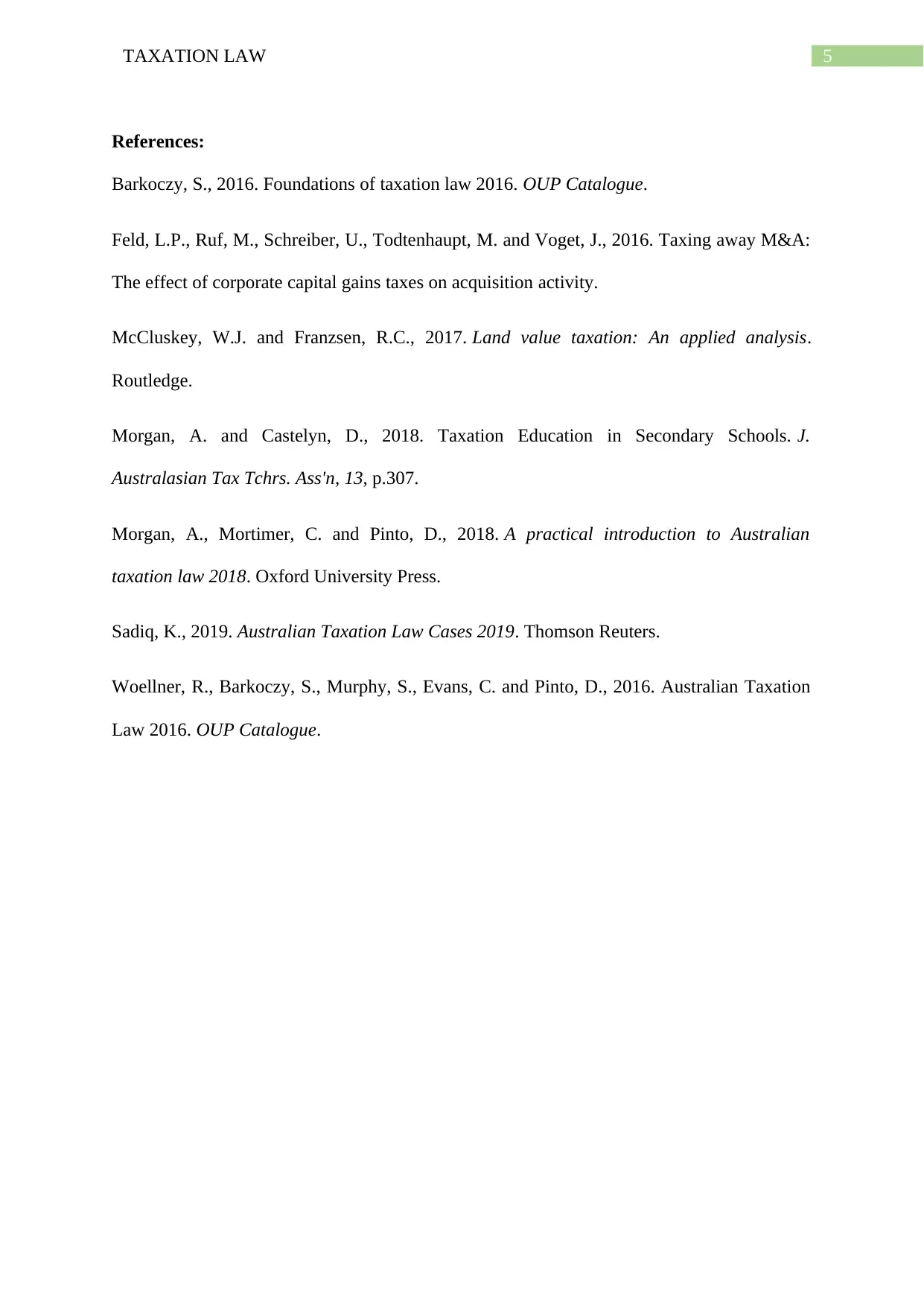
5TAXATION LAW
References:
Barkoczy, S., 2016. Foundations of taxation law 2016. OUP Catalogue.
Feld, L.P., Ruf, M., Schreiber, U., Todtenhaupt, M. and Voget, J., 2016. Taxing away M&A:
The effect of corporate capital gains taxes on acquisition activity.
McCluskey, W.J. and Franzsen, R.C., 2017. Land value taxation: An applied analysis.
Routledge.
Morgan, A. and Castelyn, D., 2018. Taxation Education in Secondary Schools. J.
Australasian Tax Tchrs. Ass'n, 13, p.307.
Morgan, A., Mortimer, C. and Pinto, D., 2018. A practical introduction to Australian
taxation law 2018. Oxford University Press.
Sadiq, K., 2019. Australian Taxation Law Cases 2019. Thomson Reuters.
Woellner, R., Barkoczy, S., Murphy, S., Evans, C. and Pinto, D., 2016. Australian Taxation
Law 2016. OUP Catalogue.
References:
Barkoczy, S., 2016. Foundations of taxation law 2016. OUP Catalogue.
Feld, L.P., Ruf, M., Schreiber, U., Todtenhaupt, M. and Voget, J., 2016. Taxing away M&A:
The effect of corporate capital gains taxes on acquisition activity.
McCluskey, W.J. and Franzsen, R.C., 2017. Land value taxation: An applied analysis.
Routledge.
Morgan, A. and Castelyn, D., 2018. Taxation Education in Secondary Schools. J.
Australasian Tax Tchrs. Ass'n, 13, p.307.
Morgan, A., Mortimer, C. and Pinto, D., 2018. A practical introduction to Australian
taxation law 2018. Oxford University Press.
Sadiq, K., 2019. Australian Taxation Law Cases 2019. Thomson Reuters.
Woellner, R., Barkoczy, S., Murphy, S., Evans, C. and Pinto, D., 2016. Australian Taxation
Law 2016. OUP Catalogue.
⊘ This is a preview!⊘
Do you want full access?
Subscribe today to unlock all pages.

Trusted by 1+ million students worldwide
1 out of 6
Related Documents
Your All-in-One AI-Powered Toolkit for Academic Success.
+13062052269
info@desklib.com
Available 24*7 on WhatsApp / Email
![[object Object]](/_next/static/media/star-bottom.7253800d.svg)
Unlock your academic potential
Copyright © 2020–2025 A2Z Services. All Rights Reserved. Developed and managed by ZUCOL.





